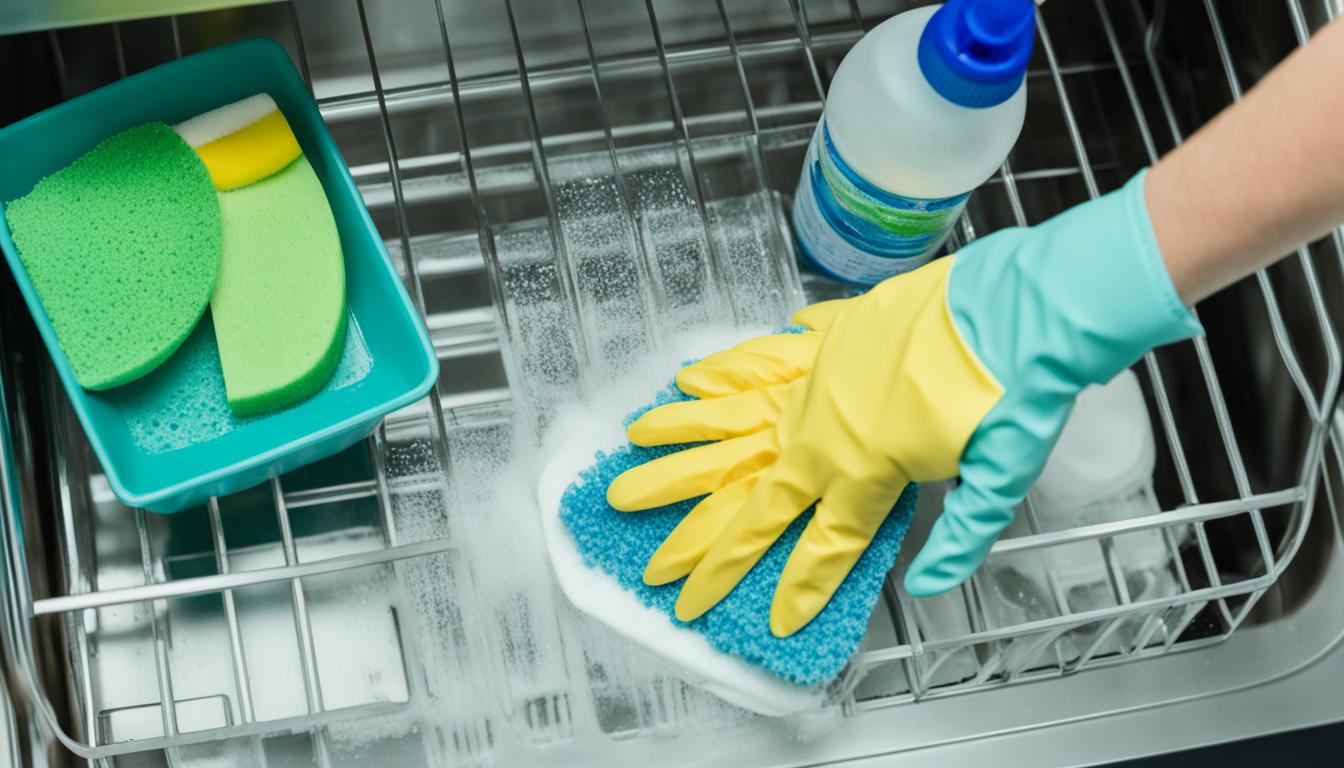Welcome to our comprehensive guide on how to clean your dishwasher and ensure its optimal performance for years to come. A clean dishwasher not only guarantees hygienically clean dishes but also extends the lifespan of your appliance. Our easy-to-follow tips and tricks will help you maintain a spotless dishwasher without any hassle.
Regular maintenance and cleaning are essential for keeping your dishwasher in peak condition. By following our dishwasher cleaning tips, including the best way to clean your dishwasher and a comprehensive dishwasher maintenance guide, you can prevent odors, mold growth, and other issues while enjoying sparkling clean dishes every time.
In this article, we will cover various aspects of dishwasher cleaning, starting with removing leftover food bits and wiping away grime on the door. We will also discuss how to clean the dishwasher filter, deep-clean the interior, and polish the exterior. By incorporating these effortless cleaning methods into your routine, you can improve dishwasher performance and prevent the growth of mold and odors.
How to Clean Dishwasher?
Removing Leftover Food Bits
One of the main causes of remove dishwasher odor problems in dishwashers is leftover food. After each dishwashing cycle, take the time to remove any remaining bits of food that have fallen into the filter well or gotten stuck to the screen or heating element. This simple step can help prevent odors and future buildup. Additionally, remember to wipe excess food from plates, silverware, and other items before loading them into the dishwasher to prevent unwanted smells.
Regular maintenance plays a crucial role in dishwasher maintenance and odor prevention. By removing leftover food bits from the dishwasher and ensuring that the items you load are free from excess food, you can keep your dishwasher running efficiently and eliminate unpleasant odors. This practice also helps how often to clean dishwasher* filter, as it reduces the chances of clogging and improves the overall cleaning performance of your appliance.
To clean the filter effectively and how to clean dishwasher filter, follow these steps:
- Refer to your dishwasher’s user manual to locate the filter and understand how to remove it safely.
- Unlock the filter and take it out from below the bottom spray arm.
- Rinse the filter under hot running water to remove loose debris.
- Use a soft toothbrush to scrub the mesh screen and plastic frame, removing any grease or particles stuck in the crevices.
- Rinse the filter again to ensure it is clean and free from any residue.
- Lock the filter back into place before operating the dishwasher to avoid any potential damage.
Dishwasher Filter Cleaning Frequency
It’s essential to clean the dishwasher filter regularly to maintain optimal performance. The frequency of cleaning may vary depending on your dishwasher usage and the type of food particles typically present in your dishes. As a general guideline, aim to clean the dishwasher filter at least once a week. However, if you notice any clogs or persistent odors, consider increasing the frequency to ensure effective filtration and cleanliness.
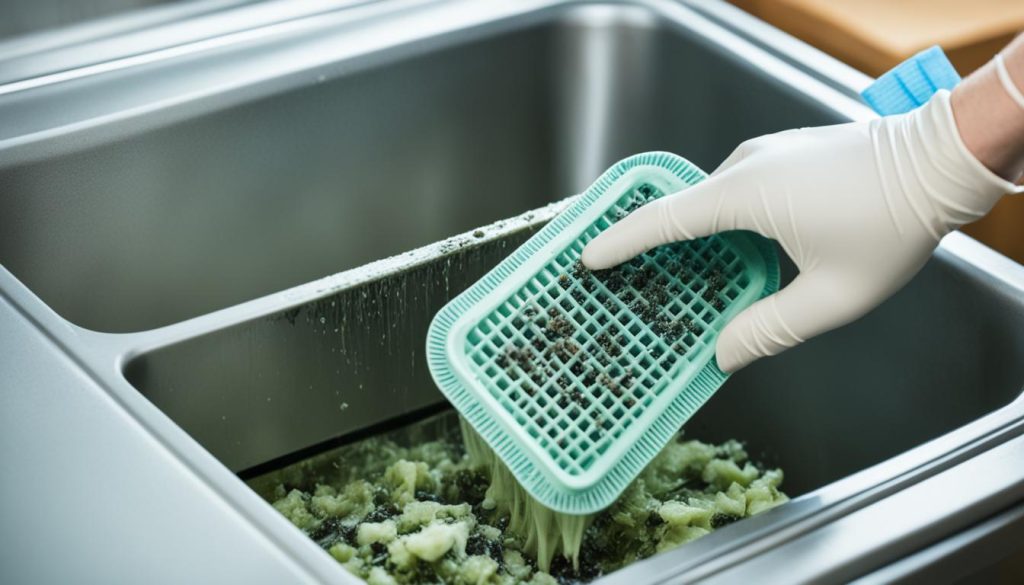
| Dishwasher Filter Cleaning Frequency | Recommended | Exceptions/Additional Considerations |
|---|---|---|
| General Usage | At least once a week | – |
| Heavy Usage or Stubborn Odors | Twice a week or as needed | If you notice clogs or persistent odors, consider increasing the frequency. |
| Infrequent Usage or Light Load | Every 1-2 weeks | – |
Regularly removing leftover food bits and cleaning the filter will ensure that your dishwasher operates at its best, how to clean dishwasher routine maintenance while also preventing unpleasant odors. By incorporating these simple practices into your dishwasher care routine, you can enjoy cleaner and more hygienic dishes with every wash.
Wiping Away Grime on the Door
The dishwasher door can accumulate greasy residue and splatters over time. To clean the door and ensure a clean surface, use a damp microfiber cloth or sponge to wipe away any grime on the interior surface of the door, bottom of the dishwasher, door edges, handle, and dishwasher controls.
Additionally, scrub the rubber seal around the door and clean the dispensers to remove any debris or traces of undissolved detergent. Avoid using bleach-based cleaners, especially on stainless steel interiors, as they can damage the surface. Instead, consult your owner’s manual before using hydrogen peroxide for mold or mildew removal.
Quick Tips for a Clean Dishwasher:
- Regularly wipe down the interior surface, door edges, and dishwasher controls to remove grime and maintain a clean appearance.
- Scrub the rubber seal around the door to remove any debris or mold buildup.
- Clean the dispensers to ensure proper detergent and rinse aid distribution.
Preventing Grime Buildup:
To prevent grime buildup on your dishwasher door:
- Wipe away food particles from plates and utensils before loading them into the dishwasher.
- Avoid overloading the dishwasher, as this can lead to poor cleaning performance and residue buildup.
- Regularly clean the filter to prevent food particles from clogging the spray arms and causing grime to accumulate.
- Run a cleaning cycle with vinegar or a commercial dishwasher cleaner to remove any stubborn grime or residue.
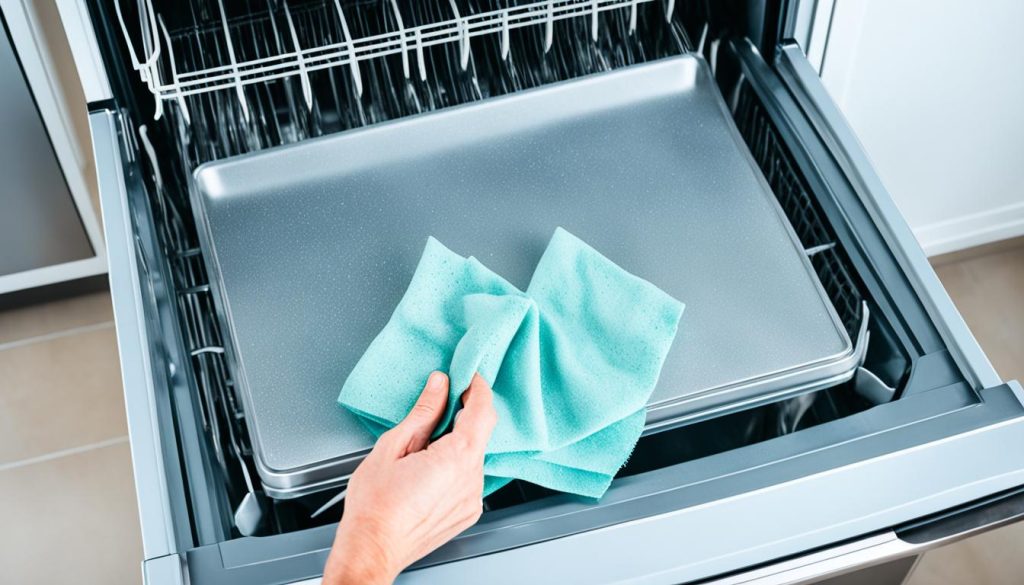
Choosing the Right Cleaning Products:
When cleaning your dishwasher, it’s important to use the right products that are safe for your specific dishwasher model. Refer to the manufacturer’s care instructions to determine the best cleaning agents to use.
| Product | Benefits |
|---|---|
| Vinegar | Natural and effective for removing odors and mineral deposits |
| Baking soda | Great for removing tough stains and deodorizing the dishwasher |
| Commercial dishwasher cleaner | Formulated specifically for dishwasher cleaning, providing a deep clean and removing stubborn grime |
By following these dishwasher care instructions and using the right cleaning products, you can keep your dishwasher clean, odor-free, and functioning optimally for years to come.
Cleaning the Dishwasher Filter
The dishwasher filter is a crucial component that helps trap food particles and prevent them from clogging the spray arms, leading to a decline in dishwasher performance. Regularly cleaning the filter is essential to ensure optimal functionality. Here’s a step-by-step guide on how to clean your dishwasher filter:
- Start by unlocking and removing the dishwasher filter, which is located below the bottom spray arm. The filter is designed to be easily accessible for cleaning purposes.
- Rinse the filter under hot running water to remove any loose debris and food particles. This will help prevent further accumulation and potential blockages.
- Next, use a soft toothbrush to scrub the mesh screen and plastic frame of the filter. Focus on removing any stubborn grease, residue, or particles that may be trapped in the crevices. This thorough cleaning will ensure that the filter is free from any obstructions.
- After scrubbing the filter, rinse it again under hot running water to remove any loosened dirt and ensure a thorough clean.
- Once the filter is clean, make sure to lock it back into its original position below the bottom spray arm. This will ensure that the filter functions properly and effectively traps food particles during future wash cycles.
Regularly cleaning the dishwasher filter not only maintains optimal dishwasher performance but also reduces the risk of clogged spray arms, which can affect the cleanliness of your dishes. By following these simple steps, you can keep your dishwasher running smoothly and ensure sparkling clean results every time.
For additional dishwasher maintenance tips, refer to our comparative table below on how to clean dishwasher spray arms and dishwasher racks effectively.
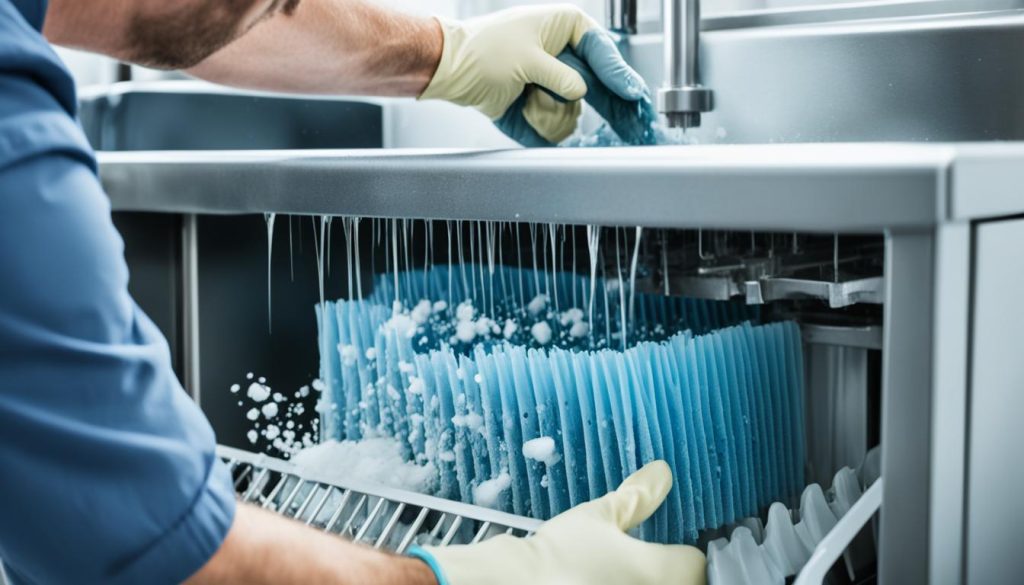
Comparative table: Dishwasher Spray Arms and Rack Cleaning Methods
| Method | Dishwasher Spray Arms Cleaning | Dishwasher Rack Cleaning |
|---|---|---|
| 1. Vinegar | Fill a dishwasher-safe cup with white vinegar and place it on the top rack of your dishwasher. Run a hot-water cycle to help remove mineral deposits and clean the spray arms. | Mix vinegar and warm water in a sink or tub. Soak the dishwasher racks in this solution for a few hours. Scrub off any remaining grime or stains before returning the racks to the dishwasher. |
| 2. Baking Soda | Create a paste by mixing baking soda with water. Apply the paste to the spray arms and let it sit for a few minutes. Scrub the spray arms with a soft brush to remove any buildup. Rinse thoroughly. | Make a thick paste by combining baking soda and water. Apply the paste to any stained or dirty areas on the racks. Scrub the racks gently, paying attention to crevices or corners. Rinse the racks thoroughly before returning them to the dishwasher. |
| 3. Commercial Dishwasher Cleaner | Follow the manufacturer’s instructions on the commercial dishwasher cleaner. Typically, you will need to empty the dishwasher, place the cleaner in a designated compartment, and run a hot-water cycle to clean the spray arms effectively. | Some commercial dishwasher cleaners are specifically designed for cleaning dishwasher racks. Follow the instructions provided on the packaging to effectively clean and remove any stains or buildup from the racks. |
Note: Consult your dishwasher’s manual for any specific cleaning recommendations or guidelines provided by the manufacturer.
Deep-Cleaning the Interior
Monthly deep cleaning of the dishwasher is essential to effectively remove trapped particles, mineral buildup, and detergent residue. This thorough cleaning process helps to maintain a fresh and efficient dishwasher. Follow these steps to deep clean your dishwasher:
- Start by removing any dish racks or removable parts from the dishwasher.
- Use a damp cloth or sponge to wipe down the interior surfaces of the dishwasher, including the walls, door, and bottom. Pay close attention to areas where food debris and residue tend to accumulate.
- For a more thorough clean, create a paste by mixing baking soda with water until it forms a thick consistency. Apply the paste to stubborn stains or areas of buildup and let it sit for about 15 minutes.
- Gently scrub the stained areas with a soft brush or toothbrush to loosen the grime. Rinse the paste away with warm water.
- If your dishwasher has a filter, remove it carefully and rinse it under running water to remove any trapped particles. Use a soft brush or toothbrush to scrub away any residual debris. Make sure to clean both the filter and the filter well.
- To ensure a deep clean, you can also use specialized dishwasher cleaning products such as Good Housekeeping Seal Star Cascade dishwasher cleaner. These dishwasher cleaners contain powerful surfactants that help dissolve and remove food bits, grease, and residue.
Follow the instructions on the dishwasher cleaner label for the recommended usage. Some cleaners may require an empty dishwasher, while others can be used during a regular wash cycle with dishes and detergent for added convenience.
A deep-cleaned dishwasher helps to eliminate odours, improve performance, and extend the lifespan of your appliance. By incorporating this monthly deep cleaning routine, you can enjoy a consistently clean and efficient dishwasher.
Recommended Dishwasher Cleaner:
For effective deep cleaning, we recommend using the Good Housekeeping Seal Star Cascade dishwasher cleaner. This cleaner is specifically formulated to dissolve and eliminate stubborn food bits, grease, and residue, leaving your dishwasher fresh and sparkling clean. Follow the instructions on the label for best results.
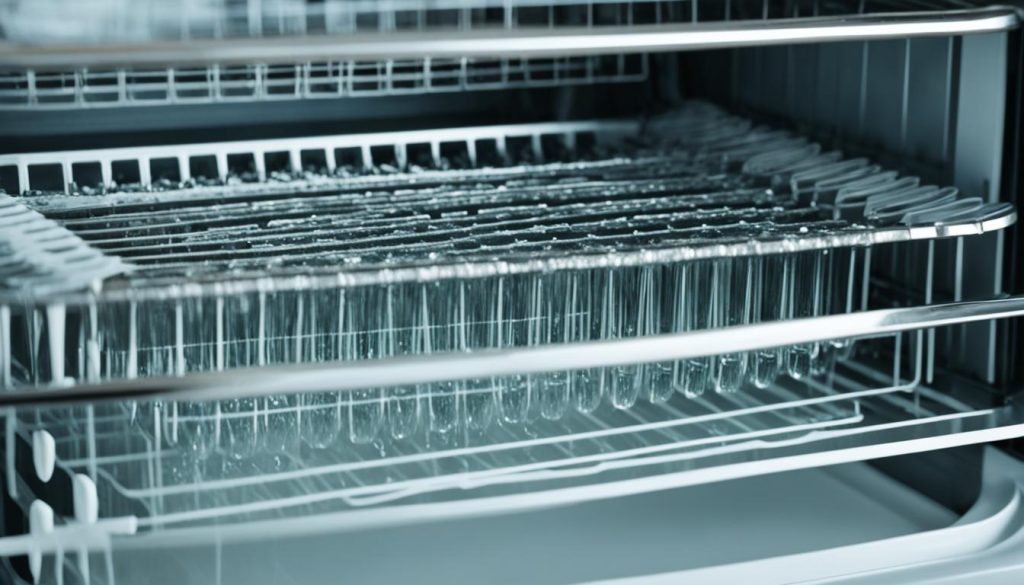
Polishing the Exterior
Fingerprints and smudges on the exterior of the dishwasher can make it look dull and dirty. To restore its shine and maintain a clean appearance, follow these steps:
- Use a stainless steel cleaner made specifically for cleaning appliances. This will help remove fingerprints, grease, and other marks from the surface of your dishwasher.
- Avoid using abrasive cleaners or pads that can scratch the surface. Opt for soft microfiber cloths or non-abrasive sponges.
- When cleaning stainless steel, always wipe in the direction of the grain to avoid streaks and maintain a uniform appearance.
- For an extra boost of cleaning power, consider using dishwasher cleaner tablets on the exterior as well. These tablets are designed to remove tough stains and grime, giving your dishwasher a fresh and clean look.
By regularly polishing the exterior of your dishwasher, you can keep it looking brand new and enhance its overall aesthetic appeal.
| Brand | Features |
|---|---|
| Cascade Platinum Dishwasher Cleaner | – Helps remove limescale and grease buildup – Leaves a fresh scent – Can be used in an empty dishwasher |
| Finish In-Wash Dishwasher Cleaner | – Deep cleans hidden parts – Fights grease and limescale – Suitable for use with dishes inside the dishwasher |
| Ecover Dishwasher Cleaner | – Natural formula – Removes grease and odors – Suitable for septic tanks |
Additional Benefits
Regular cleaning and maintenance of your dishwasher not only keep it clean and odor-free, but also improve its performance and extend its lifespan. By following these cleaning tips, you can prevent mold and mildew growth, ensure optimal performance, and enjoy spotlessly clean dishes every time.
Improved Dishwasher Performance
Regularly cleaning your dishwasher helps remove mineral buildup, soap scum, and food residue that can clog the spray arms and affect the dishwasher’s ability to clean effectively. By keeping the interior components clean and free from debris, you can ensure that the water sprays evenly and reaches all your dishes, resulting in improved cleaning performance.
Extended Dishwasher Life
Proper maintenance and cleaning can significantly extend the life of your dishwasher. By preventing the buildup of limescale, rust, and clogs, you can avoid costly repairs and extend the longevity of your appliance. Regular cleaning also helps prevent wear and tear on dishwasher parts, ensuring they continue to function optimally for years to come.
Prevention of Dishwasher Mold
Regularly cleaning your dishwasher and removing food particles, grease, and grime helps prevent the growth of mold and mildew. These unwanted microorganisms thrive in warm, damp environments, making dishwashers an ideal breeding ground. By maintaining a clean and dry dishwasher, you can prevent the development of mold, eliminate unpleasant odors, and ensure hygienic dishwashing.
By implementing these cleaning tips and incorporating regular maintenance into your dishwasher care routine, you can improve dishwasher performance, extend its life, and prevent the growth of mold and mildew. With a properly maintained dishwasher, you can enjoy clean and spotless dishes with confidence.
Conclusion
Proper maintenance and regular cleaning are essential for maintaining a clean and efficient dishwasher. By following these effortless ways to clean your dishwasher, you can ensure optimal performance, extend its lifespan, and enjoy hygienically clean dishes every time. Remember to remove leftover food, clean the door and dispensers, regularly clean the filter, deep-clean the interior, and polish the exterior as needed. With these simple tips, your dishwasher will continue to provide you with sparkling clean dishes for years to come.
FAQs
How often should I clean the filter in my dishwasher?
It is recommended to clean the dishwasher filter at least once a week to prevent clogging and maintain optimal performance.
Can I use vinegar to clean my dishwasher?
Yes, you can clean your dishwasher with vinegar. Simply place a cup of white vinegar on the top rack of an empty dishwasher and run a hot water cycle to remove mineral deposits and freshen the interior.
Is it safe to use bleach-based cleaners on my dishwasher?
It is generally best to avoid using bleach-based cleaners on your dishwasher, especially on stainless steel interiors. Consult your owner’s manual for specific cleaning recommendations, and consider using gentler alternatives like vinegar or commercial dishwasher cleaners.

